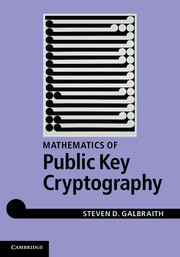Book contents
- Frontmatter
- Contents
- Preface
- Acknowledgements
- 1 Introduction
- PART I BACKGROUND
- PART II ALGEBRAIC GROUPS
- 4 Preliminary remarks on algebraic groups
- 5 Varieties
- 6 Tori, LUC and XTR
- 7 Curves and divisor class groups
- 8 Rational maps on curves and divisors
- 9 Elliptic curves
- 10 Hyperelliptic curves
- PART III EXPONENTIATION, FACTORING AND DISCRETE LOGARITHMS
- PART IV LATTICES
- PART V CRYPTOGRAPHY RELATED TO DISCRETE LOGARITHMS
- PART VI CRYPTOGRAPHY RELATED TO INTEGER FACTORISATION
- PART VII ADVANCED TOPICS IN ELLIPTIC AND HYPERELLIPTIC CURVES
- Appendix A Background mathematics
- References
- Author index
- Subject index
10 - Hyperelliptic curves
from PART II - ALGEBRAIC GROUPS
Published online by Cambridge University Press: 05 June 2012
- Frontmatter
- Contents
- Preface
- Acknowledgements
- 1 Introduction
- PART I BACKGROUND
- PART II ALGEBRAIC GROUPS
- 4 Preliminary remarks on algebraic groups
- 5 Varieties
- 6 Tori, LUC and XTR
- 7 Curves and divisor class groups
- 8 Rational maps on curves and divisors
- 9 Elliptic curves
- 10 Hyperelliptic curves
- PART III EXPONENTIATION, FACTORING AND DISCRETE LOGARITHMS
- PART IV LATTICES
- PART V CRYPTOGRAPHY RELATED TO DISCRETE LOGARITHMS
- PART VI CRYPTOGRAPHY RELATED TO INTEGER FACTORISATION
- PART VII ADVANCED TOPICS IN ELLIPTIC AND HYPERELLIPTIC CURVES
- Appendix A Background mathematics
- References
- Author index
- Subject index
Summary
Hyperelliptic curves are a natural generalisation of elliptic curves, and it was suggested by Koblitz [298] that they might be useful for public key cryptography. Note that there is not a group law on the points of a hyperelliptic curve; instead, we use the divisor class group of the curve. The main goals of this chapter are to explain the geometry of hyperelliptic curves, to describe Cantor's algorithm [105] (and variants) to compute in the divisor class group of hyperelliptic curves and then to state some basic properties of the divisor class group.
Definition 10.0.1 Let k be a perfect field. Let H(x), F(x) ∈ k[x] (we stress that H(x) and F(x) are not assumed to be monic). An affine algebraic set of the form C : y2 + H(x)y = F(x) is called a hyperelliptic equation. The hyperelliptic involution ι : C → C is defined by ι(x, y) = (x, -y - H(x)).
Exercise 10.0.2 Let C be a hyperelliptic equation over k. Show that if P ∈ C(k) then ι(P) ∈ C(k).
When the projective closure of the algebraic set C in Definition 10.0.1 is irreducible, dimension 1, non-singular and of genus g ≥ 2, then we will call it a hyperelliptic curve. By definition, a curve is projective and non-singular. We will give conditions for when a hyperelliptic equation is non-singular. Exercise 10.1.15 will give a projective non-singular model, but, in practice, one can work with the affine hyperelliptic equation.
- Type
- Chapter
- Information
- Mathematics of Public Key Cryptography , pp. 178 - 212Publisher: Cambridge University PressPrint publication year: 2012
- 1
- Cited by



